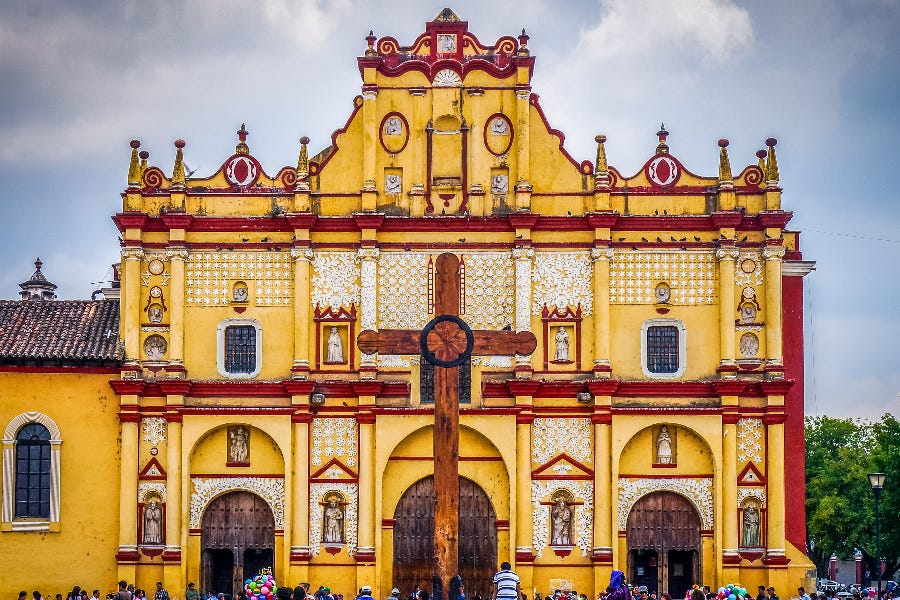
Vatican OKs ‘Indigenous liturgical adaptations’ in Mexican diocese
The Dicastery for Divine Worship recognized adaptations to the Mass for a southern Mexican diocese, but withheld approving their broader use for now
The Vatican’s liturgy department has officially recognized adaptations to the Mass for Indigenous communities in a southern Mexican diocese, but requested more information before approving their broader use.

Cardinal Arthur Roche said in a Nov. 8 letter that the Dicastery for Divine Worship had granted a formal recognitio to “adaptations presented by the Diocese of San Cristóbal de Las Casas in the Ordinary of the Mass for some Indigenous peoples of Mexico.”
But the dicastery did not immediately approve a request by Mexico’s bishops’ conference to permit the adaptations to be used by all of the country’s Indigenous groups, “with slight variations.”
Roche said the Vatican intended to accept the request, but needed to understand the nature of the variations being proposed.
“This request is due to the desire to respect the specific characteristics of each ethnic group, so that the particularities of one group are not seen as an imposition by the others,” the cardinal wrote in the letter, which was accompanied by a decree and the full texts of the liturgical adaptations.
The approved adaptations for the San Cristóbal de Las Casas diocese include the conferral of the liturgical office of “Principal” on a man or woman chosen by the community, whose role is to “guide the people, at the invitation of the priest presiding at the celebration, in moments of communal prayer.”
They also feature a “ministry of incensation,” exercised by one or more people selected by the community who oversee the use of incense at Masses.
Another adaptation is the option for thanksgiving after Communion to be expressed through “bodily movement.” Mass-goers are invited to stand in place, praying silently “with a rhythmic pendulum movement.”
Cardinal Felipe Arizmendi, the retired bishop of San Cristóbal de Las Casas, said the Vatican’s recognitio was “very significant, because it is the second case in the entire post-conciliar history in which liturgical adaptations have been approved.”
In a Nov. 13 article for Exaudi outlining the adaptations, he noted that the first was the Zaire Use, approved in 1988 for dioceses in the Democratic Republic of the Congo (formerly Zaire).
Australia’s bishops formally approved an Aboriginal liturgy in May this year. The liturgy, known as the Mass of the Land of the Holy Spirit, or Missa Terra Spiritus Sancti in Latin, is intended for use in the Diocese of Broome, in the state of Western Australia.
Around 23 million people out of Mexico’s population of almost 130 million identify as Indigenous. Sixty-two Indigenous languages are classified as national languages.
Roche’s letter, published by ACI Prensa, specified that the recognitio applied to “adaptations to the Ordinary of the Mass in Spanish for the Tzotzil, Ch’ol, Tojolabʼal, and Zoque communities (pending approval of the translation of the Ordo Missae [Order of Mass] into each of their languages), and of its translation into the Tzeltal language.”
The San Cristóbal de Las Casas diocese, which dates back to 1539, serves around 1.6 million Catholics out of a total population of 2.5 million. It covers part of Chiapas, Mexico’s southernmost state and home to a sizable Indigenous population.
The Tzotzil people are an approximately 400,000-strong Indigenous Maya people in the central Chiapas highlands.
The Ch’ol are another Maya people, numbering around 220,000 and located mainly in the northern Chiapas highlands.
The Tojolabʼal are also a Maya people, scattered across Chiapas and numbering around 85,000.
The Zoque are a roughly 40,000-strong Indigenous community mainly in northern Chiapas.
Cardinal Roche’s Nov. 8 letter also announced that the liturgy dicastery had given its confirmatio to translations of several liturgical documents, including the General Instruction of the Roman Missal, into Tzeltal, a Mayan language spoken in parts of Chiapas.
Following the arrival of Catholicism in the region, Mass was celebrated in Latin and then Spanish.
In October 2013, Pope Francis approved the celebration of Mass, and sacraments such as baptism and confession, in the Tzotzil and Tzeltal languages in the San Cristóbal de Las Casas diocese, where many Indigenous people reportedly speak little Spanish.
In his 2020 post-synodal apostolic exhortation Querida Amazonia, the pope said that Vatican Council II had called for the inculturation of the liturgy among Indigenous peoples.
“Over 50 years have passed and we still have far to go along these lines,” he wrote.
Cardinal Arizmendi, who is responsible for the doctrine of the faith within Mexico’s bishops’ conference, presented the liturgical adaptations at the bishops’ plenary assembly on April 17-21, 2023, reportedly gaining the approval of 103 of the 105 voting bishops.
Archbishop Rogelio Cabrera López, the then bishops’ conference president, requested the Vatican liturgy dicastery’s approval for the adaptations in a letter dated April 19, 2023.
In July 2023, Arizmendi told ACI Prensa it was wrong to think of the adaptations as establishing a new liturgical rite.
“It’s not a question of creating a new Indigenous rite but of incorporating into the liturgy various ways of relating to God of these peoples and which express the same thing as the Roman rite, but in its cultural form,” he said.
In a Nov. 14 video, Arizmendi insisted the adaptations for the San Cristóbal de Las Casas diocese were “not about destroying the liturgy, on the contrary, it is about making it a culture.”
He said: “We thank God and hope that this will continue so that others will also be encouraged to look for ways of inculturating the liturgy, so that the liturgy can also be part of the people.”











And yet the Traditional Latin Mass is somehow wrong.
It’s almost like that whole “sole expression of the Roman Rite” thing was just made up nonsense…